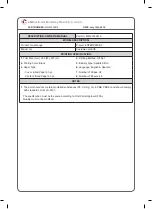
26
Care and Cleaning
CARE AND CLEANING
Cleaning Various Parts of Your Oven
Before cleaning any part of the oven, ensure all controls are turned off and the oven is cool. Remove spills and any heavy soiling as
soon as possible.
Surface Type
Recommendation
Control knobs
Painted body parts
Painted decorative trims
Aluminum, plastic, or vinyl
trim
Use a soft cloth and clean with mild dish detergent and water or a 50/50 solution of vinegar and
water. Follow by rinsing the area with clean water; dry and polish with a soft cloth. Glass cleaners
may be used if sprayed on a soft cloth first. Do not spray liquids directly on the oven control and
display area. Do not use large amounts of water on the control panel. Excess water on the control
area may cause damage to the appliance. Do not use other liquid cleaners, abrasive cleaners,
scouring pads, or paper towels. They will damage the finish.
Control panel
Decorative trim)
Use a soft cloth and clean with mild dish detergent and water or a 50/50 solution of vinegar and
water. Follow by rinsing the area with clean water; dry and polish with a soft cloth. Glass cleaners
may be used if sprayed on a soft cloth first. Do not spray liquids directly on the oven control and
display area. Do not use large amounts of water on the control panel. Excess water on the control
area may cause damage to the appliance. Do not use other liquid cleaners, abrasive cleaners,
scouring pads, or paper towels. They will damage the finish.
Stainless Steel
Only use cleaners and polishes specifically manufactured for cleaning stainless steel. Always rub in
direction of metal grain to avoid damaging. Do not use cleaners with high concentrations of
chlorides or chlorine. Do not use harsh scrubbing cleaners. Polish with a lint-free cloth. Be sure to
wipe excess cleaner/polish off from the metal surface as bluish stains may occur during future oven
heating that cannot be removed. Clean heavier soils with hot, soapy water and a cloth or sponge.
Use clean water to rinse; use a cloth to dry.
Porcelain enamel parts
Porcelain enamel broiler pan
Inserts
Door liner and body parts
Gentle scouring with a soapy scouring pad will remove most spots. Rinse with a 1:1 solution of clear
water and ammonia. If necessary, cover difficult spots with an ammonia-soaked paper towel for 30
to 40 minutes. Rinse with clean water and a damp cloth, and then scrub with a soap-filled scouring
pad. Rinse and wipe dry with a clean cloth. Remove all cleaners or the porcelain may become
damaged during future heating.
Oven interior
Remove oven racks from the oven cavity before cleaning the oven interior. Use a mild, abrasive
cleaner following manufacturer’s instructions. Rinse with clean water and dry. For very important
cleaning precautions, read
“Cleaning the Oven”
on
page 24
.
Oven racks
Glide racks
Oven racks and oven rack supports must be removed
from oven cavity during the self clean
cycle for cleaning.
Clean by using a mild, abrasive cleaner following manufacturer’s instructions. Rinse with clean
water and dry.
Oven door window (interior)
Use a small amount of ceramic glass cleaner to remove residue on oven glass.
Oven door
Use soap and water to thoroughly clean the top, sides, and front of the oven door. Rinse well. You
may use a glass cleaner on the outside door glass. Do not immerse the door in water. Do not spray
or allow water or the glass cleaner to enter the door vents. Do not use oven cleaners, cleaning
powders, or any harsh abrasive cleaning materials on the outside of the oven door.
The oven gasket is essential for a good seal. It is located on the inner frame of the door and visible
when the door is opened. Do not clean the oven door gasket. On self clean models, the oven door
gasket is made of a woven material. Care should be taken not to rub, damage, or remove this
gasket.
Cooktop surface, burners
and burner grates
Do not use spray oven cleaners on the cooktop.
“Cleaning the Sealed Burners”
instructions on
page 28
.










































